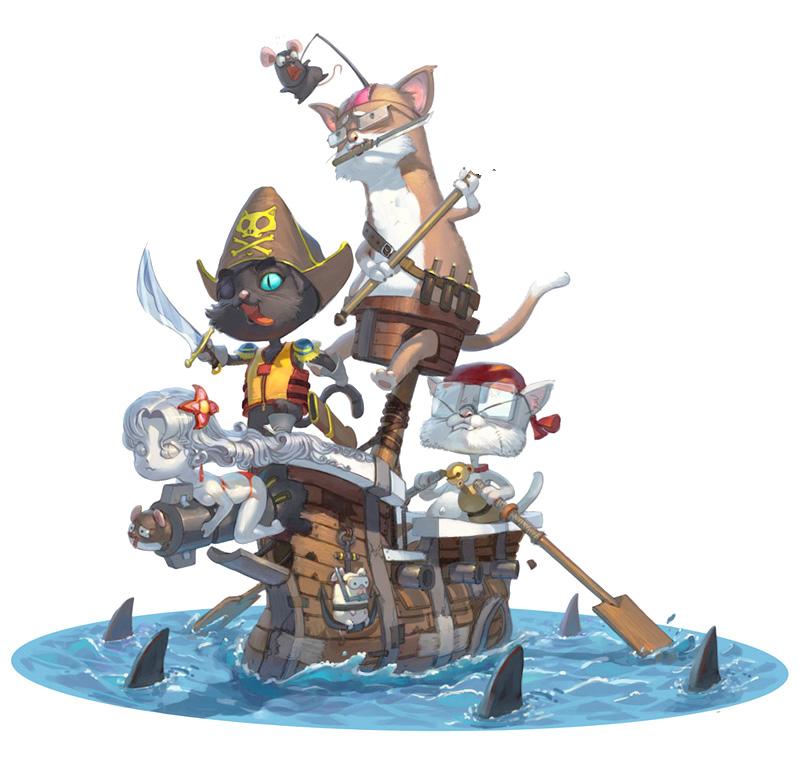
4 minute read
Cats vs Island
• Did you know that cats have been ranked as one of the world’s 100 worst invasive species? In fact, cats can be devastating to local wildlife, especially when confined to islands. One study estimated that 14% of all vertebrate vanishings on islands can be blamed on cat infestations.
• Cats originally expanded their populations around the world, largely from traveling aboard ships where they were kept to control rodents. Upon landing at various remote outposts, some of these cats ventured off the vessels and established new populations on land. In many cases, this feline invasion caused the demise of a great number of native species.

Cat populations expanded to unsuspecting new lands aboard ships, where they were kept to control rodents.
• Domestic dogs that go feral have a difficult struggle finding food and maintaining their population without the aid of mankind. However, domestic cats who go feral are natural hunters that capture indigenous prey for food. They are able to thrive independently and reproduce their numbers without any help at all from humans.
• Marion Island off the coast of South Africa is a forbidding and rocky landscape with a harsh climate and a lot of volcanic activity. Two cats released on this island in 1949 resulted in over 2,000 surviving descendants 25 years later. The cats had been brought in to control the rodent population, as the invasive rats and mice(escapees from previous ship landings) were affecting the island's bird population. The cats brought the rodent population under control, but also decimated the birds. After a concerted effort and at enormous expense, all cats were finally removed from the ecosystem by 1991.
• A report blamed domesticated cats as a factor in the disappearance of 89 out of Australia’s 138extinct or nearly extinct mammal species.
• The Balearic Islands off the coast of Spain was once covered by a particular type of shrub found only on those islands. The shrub reproduced by seeds, but the seeds could not sprout unless they were first eaten and then excreted by a certain type of lizard that also lived only on those islands. When cats arrived they ate all the lizards, which then went extinct. The shrub later died out entirely as well.

Be sure to tell our advertisers you saw their ad in Tidbits; without them Tidbits wouldn't be possible!
• A similar problem occured on Macquarie Island located halfway between New Zealand and Antarctica, when an invasive cat population threatened to overrun the land. The cats were subsequently removed, but their absence then resulted in exploding numbers of similarly invasive rabbits. The rapidly reproducing rabbit population soon overran the island, eating up almost all of the plant life. With no vegetation on the steep mountainsides to provide soil integrity, heavy rains resulted in massive mudslides that wiped out much of the island's population of native penguins that lived below.
• The Key Largo wood rat is found only on the island of Key Largo south of Florida. It was so critically endangered that an artificial breeding program was begun in 2005 to preserve the dwindling species. Wood rats raised in Disney’s Animal Kingdom in Orlando, Florida were released on Key Largo to increase the population and prevent its extinction. After repeated attempts, however, the rats would invariably end up being killed by the local feral cats that also inhabit the island. The program was finally scrapped as a lost cause in 2012.
• Stephens Island is a speck of land off the coast of New Zealand. In 1894, a lighthouse was built on the tiny island as a navigation aid for passing ships. When David Lyall arrived there as its first lighthouse keeper, he brought along his pregnant cat for company. The resulting litter soon roamed and explored the entire island, returning to the lighthouse and proudly bringing Lyall all sorts of dead birds they had killed.
• Lyall was an amateur ornithologist, so he carefully examined each bird and was excited to discover examples of an unknown species of wren. He sent several preserved bodies off to ornithologists, who agreed that it was a heretofore unknown species. They dubbed the new bird the Stephens Island wren, and asked Lyall to send more samples. Lyall tried to comply, but he was finding it increasingly difficult to find more samples of the tiny bird. By the time a year had passed from his initial discovery, he could find none at all.
• In the span of a single year, Lyall’s cats had discovered and then decimated the entire population of the new wren species, which was now completely extinct. Lyall may have been the only human to have ever seen bird alive in real life.
• When a new lighthouse keeper took over in 1899, he removed over 100 cats from the island. Yet it took another quarter of a century of feline captures and removal before Stephens Island was once again cat-free.

